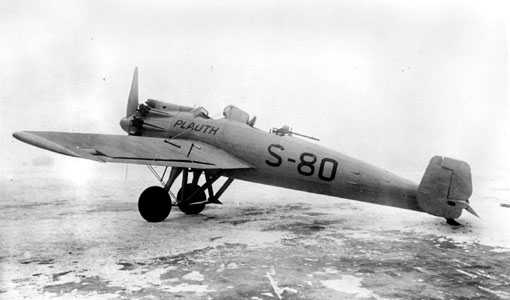The Stuka
(short for Sturzkampfflugzeug or dive bombers) is one of the best known wartime
Luftwaffe combat types and certainly the easiest to recognize with its inverted
gull wings and fixed undercarriage. Like many Lufwaffe aircraft, the Ju 87 was
designed to provide tactical support to the army in land actions.
Although dive bombing was used as an attack technique in World War I, no aircraft in that conflict was specifically designed for the role. Junkers developed the first dedicated dive bomber, the K47, in the 1920s and test flew the aircraft in 1928. Most of these aircraft were exported to China amidst great secrecy because Germany was still bound by post World War I agreement that it should not be producing weapons of war.
 |
| JUNKERS K47 |
German
strategist saw the potential of the dive bomber as an effective weapon when
used in close support of ground forces, reducing the enemy’s resistance before
ground forces advance. Still amidst great secrecy, Germany decided to manufacture
dedicated dive bomber aircraft, and in 1933 Henschel developed the Hs123 while
Junkers continued to work on their K47. The Henschel design was a biplane, but
the Ju 87 (derived from the K47) was a single engine monoplane which broke with
the Junkers tradition of corrugated skin construction. The prototype was
powered, ironically as later events proved, by a Rolls-Royce Kestrel engine,
and had its maiden flight in May 1935. The Luftwaffe was very impressed by the
potent new dive bomber and, with testing complete, the Stuka began to enter
service in 1937. These early Stukas were sent to Spain and the Civil War for
operational evaluation with the German Condor Legion.
In the
first production version, the Ju 87A-1 a single fin replaced the two of
prototype, dive brakes were fitted to Junkers Jumo 210Ca 640hp engine. The A-2
model can be by the supercharged 680hp Jumo 210Da.
By early
1939, all the A series aircraft were relegated to training duties, and all dive
bomber units began equipping with the more powerful Ju 87B series, powered by
the 1200hp Jumo 211Da direct injection engine. More streamlined spats over the
landing gear appeared, and the latest Stukas were now equipped with an
automatic dive control. The B-2 was improved further and could carry up to
2200lb of bombs. The D series fitted with the 1410hp Jumo 211J-1 engine
introduced more armour to protect the crew. Various sub types saw action
including night ground attack versions armed with cannon. From 1942 the Ju
87G-1 dedicated anti tank version was in action on the Easter Front.
The Stuka’s
automatic dive control enabled the pilot to pre set a pull out height should he
black out
in course
of a steep dive bombing attack. On commencing the dive attack the pilot
adjusted the dive angle manually by referring to red indicator lines painted on
the canopy showing 60, 75 and 80 degrees from horizontal. The pilot would
visually aim the aircraft at his target until a signal light on the altimeter
illuminated, telling the pilot to press the bomb released button on the top of
the control column. The automatic pull out would commence as the bombs left
their cradles. The bombs would follow the same course to the target as the
aircraft had during its dive while the pilot would experience around 6g as the
aircraft automatically levelled out to begin its climb skywards.
The rear
gunner operated a machine gun which might keep defending fighters at a safe
distance, but a Stuka was easy prey for fast modern fighters. With air
superiority achieved and against obsolete fighters in Poland and the Low
Countries the Stuka was able to hold its own, but when it came up
against the Hurricanes and Spitfires of RAF large numbers were destroyed on
cross channel missions. The Ju 87 had a slow top speed and could not climb away
quickly. Accordingly, it was withdrawn from operations against the UK but the type continued to serve in Greece, Crete, North Africa, Malta
and on the Eastern front.
The Stuka
was more than a dive bomber it was also a psychological weapon. The wheel
covers were fitted with sirens that would wind up as the aircraft went into
their dive this created terror among the enemy below. Whistles were also known
to be fitted on to the fins of the bombs to ensure a similar effect as the
ordnance fell. The total number of Stukas produced was around 5700 aircraft.
Junkers Ju
87D-1
First
flight: 1940.
Power: 1
Junkers 1410hp Jumo 12 cylinder piston engine.
Armament:
Two 0.31in machine guns in wings and two in rear cockpit; up to 3962lb bomb
load.
Size:
Wingspan – 45ft 3.5in
Length – 37ft 8.75in.
Height – 12ft 9.5in.
Wing area – 343.38sq ft.
Weights:
empty – 8584lb.
Maximum take off – 14,526lb.
Performance:
Maximum speed – 255mph.
Diving speed – 372mph.
Ceiling – 23,915ft.
Range – 954 miles.
Climb 16,405ft in 19
minutes 48seconds.


/images/Junkers-Ju-87A1-Stuka-1.StG165-(52+A11)-Germany-1938-01.jpg)




No hay comentarios:
Publicar un comentario